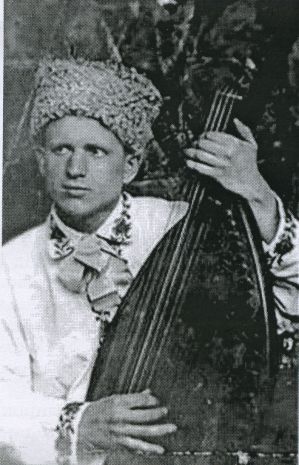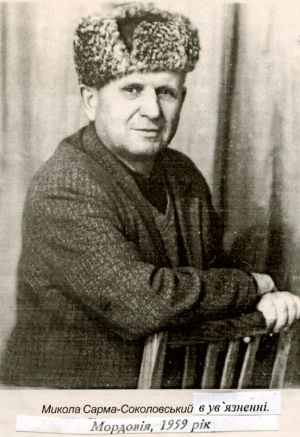SARMA-SOKOLOVSKY, MYKOLA OLEKSANDROVYCH (b. May 19, 1910, in the village of Khoroshe, Pavlohrad County, Katerynoslav province (now Petropavlivsk Raion, Dnipropetrovsk Oblast) – d. August 9, 2001, in Novomoskovsk, Dnipropetrovsk Oblast).
Artist, *kobzar*, poet, priest of the UAOC, member of the OUN underground, political prisoner.
His father, Oleksandr Oleksiyovych Sokolovsky, was a descendant of Cossacks, a teacher at a church-parish school, and was ordained as a priest of the Ukrainian Autocephalous Orthodox Church (UAOC) in 1918, assigned to a parish in the village of Pryvilne, Solonyansky County. In 1923, he was executed by the Chekists without trial or investigation for burying fallen insurgents from Tryfon Hladchenko's detachment.
Mykola Sokolovsky studied at the village school. In 1925, he entered the Myrhhorod Art and Ceramics School named after Gogol. His drawing teacher was the artist Fotiy Krasytsky, a grandnephew of Taras Shevchenko. In Myrhhorod, Sarma-Sokolovsky learned to play the bandura from the *kobzar* Ivan Yarosh, with whom he performed. In June 1926, he moved to Dnipropetrovsk, enrolled in a two-year course at the art and industrial school, and played in the bandurist chapel of the railway workers' club, which traveled to villages with concerts.
He was arrested in August 1929 on fabricated charges by the GPU of involvement in the Union of Ukrainian Youth (SUM), allegedly for conducting “chauvinistic propaganda” with a group of bandurists. He was tortured by investigators Druyan and Kes. In the pretrial detention center, he was held with those accused in the “SVU case,” including Mykhailo, the brother of Academician Yefremov, and his son Kost. In early 1930, he was sentenced to 5 years of imprisonment. He arrived by transport to the port of Kem on the shore of the White Sea and was supposed to be sent to Solovki, but since Solovki was overcrowded, the transport was returned to the station of Prandovo to build the Prandovo tract. Sarma-Sokolovsky escaped with two other prisoners toward Finland. A week later, border guards accidentally stumbled upon the sleeping fugitives, killed one, and returned the other two to the camp. Sarma-Sokolovsky was saved from execution by the camp commander, V. Kornilov, for whom he had painted a portrait of his son shortly before the escape.
He served his sentence in Karelia (USLON, USLAG, BELBALTLAG). In 1934, he was released. He went to the Donbas, to Kramatorsk, where his brother Leonid worked and where his mother and younger children had already moved. There he was drafted into military service. Due to his criminal record, he was placed in a rear echelon battalion. In the spring of 1935, the battalion was being transferred from Dnipropetrovsk to the Far East. The train was stopped for a long time in Nizhny Novgorod due to a flood, and the militiamen were forced to work on the construction of a bridge across the Oka River. Sarma-Sokolovsky escaped from there and returned to Dnipropetrovsk.
After forging his military documents and obtaining a passport, Sarma-Sokolovsky, on the recommendation of the artist Fedir Krasytsky, was admitted directly to the second year of the Kyiv Art Institute. After graduating in 1938, he worked as an artist at a cultural center in Simferopol. In 1939, he married Dina Shmatko, a graduate of the Kyiv Art Institute. In 1939, their daughter Oksana was born. From 1940, he worked at the Poltava House of Folk Art. As a budding poet, he debuted in the newspaper “Komsomolets Poltavshchyny,” although he was not a Komsomol member, and he became acquainted with the artist Kateryna Bilokur.
In June 1941, Sarma-Sokolovsky was at a military retraining exercise with the rank of an officer in the quartermaster service. During the evacuation, the train carrying his unit was bombed at night. Sarma-Sokolovsky escaped and made his way to Poltava, which was already occupied by the Germans. He earned a living by painting. In December 1941, in Kyiv, he solemnly took an oath as a member of the OUN (Organization of Ukrainian Nationalists) and became the OUN(m) leader for the Poltava region. In 1942, he studied at the six-month pastoral courses of the UAOC. Bishop Mstyslav (Skrypnyk) ordained him as a deacon, and Bishop Sylvestr as a priest, in the very Protection Church built by Petro Kalnyshevsky, where Sarma-Sokolovsky had restored the icons. In 1942, the Gestapo arrested 12 OUN members in Poltava, including his wife Dina Shmatko-Sokolovska, and they were executed. To provide a mother for his three-year-old child, he married Varvara Klymko, who gave birth to two daughters, Lesia and Yevhenia. He had to move from Poltava to the village of Ripnytsi in Podillia, where he received a parish, and later to Bukovyna, to the village of Rarancha.
In December 1944, Sarma-Sokolovsky was arrested by the NKVD. On February 19, 1945, he escaped from a transport, although he was wounded in the arm, returned to Bukovyna, and went into hiding. In May, he was captured in a hideout during a raid. On May 16, he managed to escape from a transport again. In the city of Kolomyia, he joined the OUN underground, where he was active for two years under the pseudonym “Bodnar.” He collected weapons, exchanged money, and drew caricatures of Soviet leaders under the pseudonym “Mykola Bida.” In May 1948, he walked into an ambush. The captured and bound Sarma-Sokolovsky was taken to the Stanislav MGB, where he was interrogated and tortured by an investigator, Senior Lieutenant Dolgikh, who had a Chekist academic education. The tribunal of the Carpathian Military District sentenced Sarma-Sokolovsky to death. He spent 15 days on death row. The execution was commuted to 25 years in the camps. His wife Varvara, brothers Leonid and Anatoliy, and brother-in-law Ivan were also sentenced to 25 years—only because they were relatives of Sarma-Sokolovsky. The children were left in the care of their grandmother—Sarma-Sokolovsky's mother.
He served his sentence in Inta and Abez. His file was marked with a red stripe— “Extremely dangerous, prone to escape, to be used only in general labor.” Despite prohibitions, Sarma-Sokolovsky wrote poems even in captivity. He secretly made a bandura (and later several more) and taught fellow prisoners to play, at first secretly, and after Stalin’s death, more freely. He created an ensemble of bandurists of the GULAG in the city of Inta. In Inta, he was in close contact with translators Hryhoriy KOCHUR, Dmytro Palamarchuk, and Mykola Vasylenko.
He was released in September 1961. He worked at a factory in Voroshylovhrad. He led a bandurist group at the pedagogical institute. His poems were published in regional newspapers, in “Literaturna Ukrayina,” and in the journals “Ranok,” “Zhovten,” and “Dnipro.” But a smear campaign began again in the press, branding him a nationalist. He was forbidden from leading the bandurist group and was fired from the factory.
In 1974, Sarma-Sokolovsky exchanged his Luhansk apartment for one in Novomoskovsk, Dnipropetrovsk Oblast, and retired there. He associated with a circle of dissidents in the Dnipropetrovsk region: Serhiy ZAVHORODNIY, Oleksandr Kuzmenko, Volodymyr SIRENKO, Ivan SOKULSKY, Fedir Klymenko, Lyubov Holota, Mykola BERESLAVSKY, and others.
In 1980, under the pseudonym Sarma, he managed to publish a collection of poems, “On the Sunny Side of Summer,” with the “Radyanskyi Pysmennyk” publishing house. This enraged the KGB. Summonses to the KGB, interrogations, and slanderous publications in the press began again.
In 1984, KGB majors Anatoliy Vasylyovych Holovko and Yuriy Taraban, after expressing surprise that Sarma-Sokolovsky had not been executed in 1948, subjected the old and frail man to lengthy, exhausting interrogations and threats of reviewing his case “at the request of the people” and sending him back to serve his remaining term. They fabricated a statement in Russian on Sarma-Sokolovsky's behalf, which they forced him to read aloud before signing. A regional radio editor secretly recorded it on tape. Stunned by such treachery, Sarma-Sokolovsky signed the statement. An arbitrary translation of it was published by the newspaper “Zorya.” It contained negative characterizations of his closest friends. Naturally, they turned away from him.
After independence, Sarma-Sokolovsky became the pastor of a small UAOC church and was beloved and respected by good people. He founded district and regional OUN chapters in the Sicheslavshchyna region. In June 1994, he opened the 13th Grand Assembly of the OUN(m) with a prayer and was elected an honorary member of the OUN(m) Senate. His wife Varvara, daughters Oksana and Yevhenia, granddaughter Myroslava, and grandson Oles Sokolovsky, who heads the OUN in the Luhansk region, are all members of the OUN.
He is the author of “Song of the Kobzar” (1989), “On Purification” (1990), “Duma on Hetman Ivan Mazepa” (1992), and other works.
He is buried in Novomoskovsk, Dnipropetrovsk Oblast.
Bibliography:<
1.
*On the Sunny Side of Summer*. – Kyiv, 1980.
“‘My Past Torments Me.’” – *Zorya* newspaper (Dnipropetrovsk), July 18, 1984.
*Anathema: A Poem-Duma*. – Drohobych, 1993. – 28 pp.
*The Roots of Memory: Poems*. Ed. M. Miroshnychenko. – Kyiv: Vyd-vo im. O. Telihy, 1997. – 280 pp.: ill.
Poems. // *Zona*, No. 9, 1995, p. 124; No. 11, 1996, pp. 113-118; No. 12, 1997, pp. 14-15; No. 13, 1998, pp. 94-95.
*My Involvement with the OUN*. Kyiv–Toronto, 2000, 224 pp.; Ruthenos http://ruthenos.org.ua
“A Forced Request. A Forced Letter.” // *Zona*, No. 22, 2007, pp. 73–82.
2.“Retribution.” – *Prykarpatska pravda* newspaper, July 1, 1980.
“Under the Mask of an Artist.” – *Zhovten* journal, No. 6, 1984.
“The Four-Faced Traitor.” – *Zorya* newspaper, July 14, 1984.
Prystaiko, V., Shapoval, Yu. *The Case of the “Union for the Liberation of Ukraine.” Unknown Documents and Facts*. – Kyiv, INTEL, 1995, pp. 142-143.
Miroshnychenko, Mykola. “In the Light of a Passionate Lantern.” // Mykola Sarma-Sokolovsky. *The Roots of Memory*. – Kyiv: Vyd-vo im. O. Telihy, 1997, pp. 5–12.
“Sarma-Sokolovsky.” Material from Wikipedia http://uk.wikipedia.org
Bohdan Zheplynsky. “On the Paths of the Kobzars.” http://www.ukrcenter.com
M. Sarma-Sokolovsky. Ruthenos http://ruthenos.org.ua
Vasyl Ovsiyenko, Kharkiv Human Rights Protection Group. April 29, 2008.


In the photos: Mykola Sokolovsky (literary pseudonym Sarma) in his youth and in captivity in Mordovia in 1959.